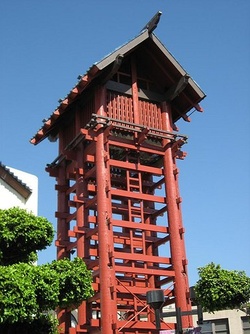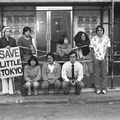This past year, I worked with students and other volunteers to conduct an inventory of businesses in Little Tokyo; seeing the results made me pause and consider the future of a place that I’ve worked in for nearly 40 years.

In the past four decades, I’ve seen profound changes. What once was a neighborhood geared towards the Japanese-speaking workers who lived in one-room hotels has morphed into an area that caters to downtown loft dwellers. Where once we had small markets and specialty stores; drug stores complete with a soda fountains; bars; cleaners; and small restaurants featuring Japanese and Chinese food at a low cost; we now see high-end apartments and pricey restaurants catering to those who delight in being able to get real sushi literally right outside their door.
Thirty years ago, Little Tokyo’s leaders bet on then-successful Japanese corporations to save the day and maintain the culture of the community, while younger activists set about creating a “Japanese American” culture by opening bookstores and telling our community’s story through the arts. This took the form of films, books, plays, and music—from taiko to modern American jazz and rock music incorporating traditional instruments like the koto. Many of this younger generation played basketball and dreamed of building a gym in Little Tokyo.
Fast forward to today.
We see Japanese traditions, such as Oshogatsu on New Year’s Day or Nisei Week in the summer, drawing thousands of Angelenos to Little Tokyo. The annual Children’s Day sponsored by the JACCC features a children’s fun run called Chibi K as well as a three-on-three basketball tournament and other cultural performances. There is East West Players, Visual Communications’ annual film festival, and American taiko has become a movement comprising some 150 groups throughout North America alone.
In the past three or four decades, Little Tokyo has learned to honor history while creating new traditions that push cultural boundaries.
One of the questions we asked in our survey of Little Tokyo businesses this past year asked the ethnicity of local business owners. Over 66 percent identified themselves as Japanese or Japanese American; 14 percent identified as Korean; and the remaining 17 percent comprised Chinese, Latino, White, African American, and Iranian individuals.
We also asked the length of time doing business; it turned out that most of the businesses that opened in the past five to ten years were not Japanese- or Japanese American-owned.
Now, don’t get me wrong. Everyone in Little Tokyo does not have to be Japanese to open a business. In fact, Little Tokyo has always been a multi-ethnic neighborhood with a strong Japanese flavor. And in keeping with that tradition, we should welcome anyone who has the community’s wellbeing at heart and will maintain Little Tokyo’s strength and vitality.
But at the same time, in order for Little Tokyo to remain “Little Tokyo,” requires that there be a critical mass of at least Japanese-themed businesses. Although currently some two-thirds of the businesses here are under Japanese ownership, the trend does reveal that this number is on the decline.
There are different ways to react to this information. We could try to create a “Japanese Only” zone with a Little Tokyo surrounded by cherry trees where people can only enter if they speak Japanese and wear kimono. (Just kidding.) Or we could get hysterical about the Koreans “taking over” and the community losing its character. But it’s hard to lose something that has taken 125 years to build.
Granted, Little Tokyo will never be the community you or I remember as a child or teen or young adult. We need to document that history for future generations. But the history, culture and traditions—both old and new—will continue to adapt because culture is a living thing whose nature is to grow and evolve with changing times.
When Sansei first began learning to play that big Japanese drum, some older members of the community took a negative stance, saying that they were not doing it in the purely traditional Japanese way. But by doing it the “wrong way” they created a new, uniquely Japanese American art and cultural form.
Just as Anime is becoming as culturally Japanese as tea ceremony or flower arrangement; or as community basketball leagues are one of the most popular ways we maintain ethnic ties with each other; there will be any number of ways we continue tradition and history, especially in light of the incredibly high rate of intermarriage and mixed-race kids who still identify with Little Tokyo and Japanese America.
If we can all embrace change and open our minds, the future looks bright.
So as we all work together to preserve the culture and history of this community, let’s do it in a way that is open to new ways of being Nikkei and new ways of looking at our neighborhood of Little Tokyo.
If we can all do that, our 125-year-old neighborhood will never die.
© 2010 Evelyn Yoshimura




